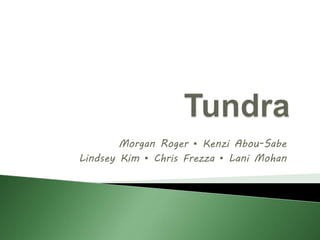
Tundra.ppt paisaje presente en chile bioma
- 1. Morgan Roger ▪ Kenzi Abou-Sabe Lindsey Kim ▪ Chris Frezza ▪ Lani Mohan
- 2. There are two types of tundra: arctic and alpine. ◦ Arctic tundra are located in the northern hemisphere. ◦ Alpine tundra are found at tops of mountains above tree line (where trees can’t grow).
- 3. Arctic Tundra Western Andreafsky Wilderness, Alaska Alpine Tundra Rocky Mountain National Park, Colorado
- 4. Arctic ◦ Average winter temperature of -4ºF to -22ºF. ◦ Average summer temperature of 20ºF to 60ºF. ◦ Little precipitation, usually less than 10 inches. Alpine ◦ More moderate temperature, but changes depending on latitude and altitude. ◦ Rarely drops below 0ºF during the winter. ◦ Average summer temperature of 50ºF. ◦ Receives more rain than arctic tundra, but the water runs rapidly off the mountains.
- 5. Arctic Tundra Alpine Tundra
- 6. Arctic ◦ Surface/Active Layer Freezes in winter and thaws when warmer. Depth of 10 inches to 3 feet. Doesn’t retain water well, so when snow melts, the soil is soggy. ◦ Lower/Inactive Layer Permafrost which remains frozen at all times. Depth of 300 to 2000 feet. Made of gravel, bedrock, clay, or silt. ◦ Poor in nutrients, which affects vegetation.
- 7. Vegetation in the tundra is comprised of patches of sedges, mosses, grasses and lichens that grow between bare rock and pools Species include: Heather Family Plants, conventional Mosses and Lichens, Marsh Grass, and Cotton Grass Nearly all tundra plants are perennials
- 9. Few woody plants, exceptions are: Dwarf Birch, Dwarf Willow, Alpine Bearberry, and conventional shrubs like Bilberry and Crowberry Tundra plants are low-growing to survive strong, winter snow-blasting On rocks: lichens grow atop the rock, while mosses/algae/fungi grow in the rock’s crevices On ground, grasses grow on drier areas, whereas sedges grow on wetter land, closer to pools In summer, perennial flowers appear, reproductive cycles resuming as daylight hours increase
- 10. Flowering plants are small because permafrost contains few nutrients Flowers of the tundra are very colorful and emerge quickly With scarce pollination, some plants use alternative reproduction
- 11. Alpine ◦ Has a layer of permafrost, but its active layer is dry because drains water well. ◦ Soil freezes and thaws. ◦ Stratified (layered) . ◦ Some regions are covered in material so weathered an thin it can’t be classified as soil.
- 12. Polar Bears Caribou Arctic Fox Arctic Hare Snowy Owl Musk Ox Rock Ptarmigan These animals live in the northern hemisphere, which includes; Canada, Russia, Greenland, Norway, and other locations. They feed on a variety of animals and plants that also live in the biome.
- 13. Humans have had to adapt to the very cold and harsh conditions of the tundra- these adaptations are mainly behavioral. Groups are forced to be creative and resourceful. North American Inuits, also known as “Eskimos,” have adapted special bodies that can digest raw meat. Inuits use caribou meat for food, the skin for tents, bedding, and clothes, antlers to make harpoons (a hunting spear), needles/tools are made from the bones, and tendons are used to make string
- 14. • The tundra has limited resources for building houses. Shelters are made from materials available- blocks of snow, sod, animal skins, or stone. Sherpas of the Himalayas build thick stone walls, and live on top of the yak stables to use the animals' warmth to heat the houses. QuickTime™ and a decompressor are needed to see this picture.
- 15. • Inuit used sleds made of animal bones and skins pulled over the ocean and ice by dogs, mainly huskies. • On the waters of the Arctic Ocean small boats called “kayaks” were used for hunting while larger boats called “umiaq” transported people, dogs, and supplies. The Kohistani people of Pakistan travel based on season- they move below the tree line (2,000 ft) during winter and live on the tundra (14,000 ft) during summer.
- 16. • Plant populations are not sustainable to grow as a food source due to a short growing season. Some societies are herders- the Sami (Russia) herd reindeer, other groups use llamas and yaks. South American Indians raise llamas for milk. Others are hunters and gatherers- hunt for meat and fish, plants supplement the diet and may be used medicinally. Barley and potatoes may be grown in more moderate alpine climates.
- 17. Worn in layers to survive cold environment. Often made of animal skins, such as caribou (warm and light). eg. parkas (hooded jackets), lined often with wolf or wolverine hair. Sealskin is waterproof and used for boots, and lined for additional warmth.
- 18. Traditionally, societies focus on finding food, and making clothing, weapons, and tools- instead of wealth or possessions. Mining minerals, natural gas, and oil are modern economic elements. The Arctic tundra is also a site of military activity (eg. Distant Early Warning Line- a series of radar stations).
- 19. Although beautiful, the Tundra landscape does not offer many resources for human settlers due to limited species diversity and harsh climate. Either: low population density. PRO: the existence of a successful mining industries provides jobs and natural gas. PRO: moving to the tundra can create jobs for natives. CON:modern society may threaten traditional ways of life.
- 20. CON: the difficulty to dispose waste. Garbage will not decompose due to cold and cannot be buried to to frozen ground. CON: the negative impact of human settlement on the tundra environment. For example, use of pesticides, pollution, interference in migration patters, and causing change in the landscape.
- 21. They are found in most of the earth's northern terrain ◦ Above timberline in the high mountains of the world, as well as the Antarctic
- 22. The tundra climate spans from most of Greenland to parts of Alaska, northern Canada, and northern Russia. The latitudinal range is 75° N to 60° N.
Editor's Notes
- er